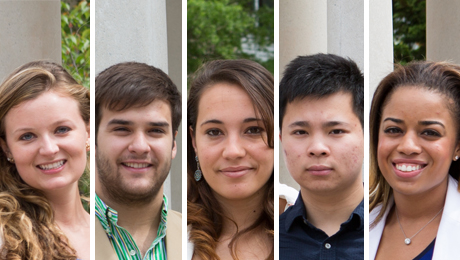By Brittney Dunkins
On Oct. 23, 2012, tropical cyclone Hurricane Sandy swept across the coast of Cuba, the first stop on a destructive journey that devastated communities from the Caribbean to the Northeastern United States.
In Santiago, the second largest city in Cuba, 29-foot waves left mountains of debris in their wake, destroying more than 15,000 homes. Among those left without shelter were the grandparents of George Washington University graduating senior Henry Palancar.
For the Cuban-born School of Engineering and Applied Sciences recent graduate, the tragedy sparked an entrepreneurial impulse.
“When my grandparents’ home was destroyed by Sandy, I knew we needed to find a universal solution to aid people in their time of need,” Mr. Palancar said.
With disaster relief in mind, he set to work on his SEAS capstone senior design project at the beginning of the academic year and came up with KOTI, a sustainable, portable shelter for victims of natural disasters.
After nearly a year of late nights in the Tompkins Hall of Engineering basement, the KOTI prototype is 95 percent complete and has become a bona-fide business venture, winning an honorable mention and $2,500 in seed funding from the Texas Christian University Ventures and Values Competition.
Designed by Mr. Palancar and his classmates-turned-business-partners SEAS graduates Alyse Stone, chief officer of operations; Rhiannon Scanlon, chief officer of sustainability; Lynnie Strother, chief global cultural relations; and Anh Nguyen, chief financial officer, KOTI—which means home in Finnish—is a home-away-from-home for victims of natural disasters.
“KOTI showcases how students can pursue their passions by taking full advantage of the resources here at GW,” Executive Director of Entrepreneurship and Technology Transfer Jim Chung said.
Mr. Palancar said that during the research phase the team met with representatives from the Red Cross, USAID and other NGOs and held interviews with more than 100 customers.
“We spoke to people who survived Katrina and Sandy and took notes on what problems they had and what they needed,” Mr. Palancar said. “We also tested all of the materials.”
KOTI is made of water-sealed plywood that is less than 3 cubic feet and weighs about 100 pounds, making it easy to store and transport.
“When my grandparents’ home was destroyed by Sandy, I knew we needed to find a universal solution to aid people in their time of need.” - Henry Palancar
Instead of turning from a car into a superhero in the vein of “Transformers,” KOTI transforms from a box into basic amenities for survivors, including two sleeping cots, a water tank and filtration system and nine amorphous solar panels powered by AAA rechargeable batteries.
The solar panels, which have a nine-hour life span, only need six hours to charge. They are mounted on a base that doubles as a table.
Other features include a 25 to 30 liter storage tank with a filter and siphon pump that holds nearly twice the amount of drinking water that a family needs each day. The filter can process up to 30 gallons of water in an hour.
“We wanted to design the tank to hold enough water for showering, doing the dishes and other tasks to help stop the spread of bacteria at disaster relief sites,” Mr. Palancar said.
The added bonus of KOTI, Mr. Palancar said, is that each of these components is made from recyclable and renewable materials that can be used in the rebuilding process.
For example, the cots, which can hold up to 350 pounds, use PVC piping that can be broken down and used to patch or rebuild plumbing. The plywood used for the base of the cots and outside of the cube can be used for putting up a door on a damaged home.
“We don’t want KOTIs back once they are finished being used,” Mr. Palancar said. “We want them to be interactive in the community and have people take them apart when the storm is over and use them for rebuilding.”
“We’re not just aiding survivors when they need clean water or bedding, we are aiding them after the storm,” he said.
KOTI doesn’t come with instructions but instead uses universal symbols, such as those used on disaster management posters.
“It is a global problem that 75 percent of disaster relief victims die within the first 72 hours,” Mr. Palancar said. “Our lightweight design makes KOTI easy to deploy through USAID, Red Cross and other NGOs.”
The team will complete the prototype and meet with potential investors during the summer. They hope to sell the product for less than $500, which is a low cost for high results, Mr. Palancar said.
“We really just want to save lives,” Mr. Palancar said. “With KOTI, we know that we that we can do that.”


